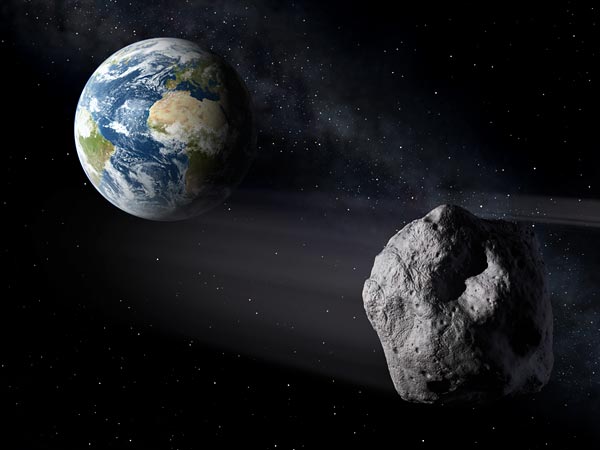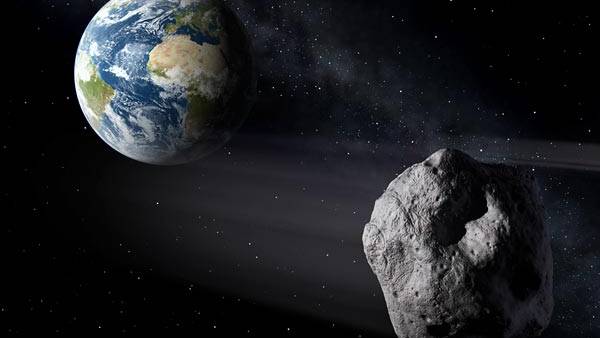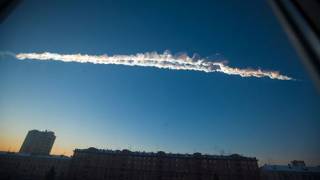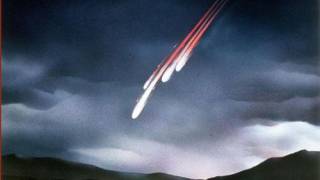Asteroid to Make Closest Flyby in History
Source: news.nationalgeographic.com

An artist’s conception of DA 14, the asteroid expected to whizz past Earth February 15 on the closest approach in history.
Researchers keeping an eye on trajectory that will bring it within 18,000 miles of Earth.
Talk about too close for comfort. In a rare cosmic encounter, an asteroid will buzz Earth next week, missing our planet by a mere 17,200 miles (27,700 kilometers).
Designated 2012 DA14, the space rock is approximately 150 feet (45 meters) across, and astronomers are certain it will zip harmlessly past our planet on February 15—but not before making history. It will pass within the orbits of many communications satellites, making it the closest flyby on record. (Read about one of the largest asteroids to fly by Earth.)
"This is indeed a remarkably close approach for an asteroid this size," said Paul Chodas, a research scientist at NASA’s Jet Propulsion Laboratory Near Earth Object (NEO) program office in Pasadena, California.
"We estimate that an asteroid of this size passes this close to the Earth only once every few decades."
The giant rock—half a football field wide—was first spotted by observers at the La Sagra Observatory in southern Spain a year ago, soon after it had just finished making a much more distant pass of the Earth at 2.6 million miles (4.3 million kilometers) away.
This time around however, on February 15 at 2:24 p.m. EST, the asteroid will be passing uncomfortably close—ten times closer than the orbit of the moon—flying over the eastern Indian Ocean near Sumatra (map). (Watch: "Moon 101.")
Future Impact?
Chodas and his team have been keeping a close eye on the cosmic intruder, and orbital calculations of its trajectory show that there is no chance for impact.
But the researchers have not yet ruled out future chances of a collision. This is because asteroids of this size are too faint to be detected until they come quite close to the Earth, said Chodas.
The flyby of asteroid 2012 DA14 on Feb. 15, 2013, will be the closest known approach to Earth for an object its size.
This NASA video explains just how close Asteroid 2012 DA14 will get to Earth, why you probably won’t see it fly by, and how they’re working on tracking other asteroids. Source: NASA/JPL-Caltech
"There is still a tiny chance that it might hit us on some future passage by the Earth; for example there is [a] 1-in-200,000 chance that it could hit us in the year 2080," he said.
"But even that tiny chance will probably go away within the week, as the asteroid’s orbit gets tracked with greater and greater accuracy and we can eliminate that possibility."
Earth collision with an object of this size is expected to occur every 1,200 years on average, said Donald Yeomans, NEO program manager, at a NASA news conference this week.
DA14 has been getting closer and closer to Earth for quite a while—but this is the asteroid’s closest approach in the past hundred years. And it probably won’t get this close again for at least another century, added Yeomans.
While no Earth impact is possible next week, DA14 will pass 5,000 miles inside the ring of orbiting geosynchronous weather and communications satellites; so all eyes are watching the space rock’s exact trajectory. (Learn about the history of satellites.)
"It’s highly unlikely they will be threatened, but NASA is working with satellite providers, making them aware of the asteroid’s pass," said Yeomans.
Packing a Punch
Experts say an impact from an object this size would have the explosive power of a few megatons of TNT, causing localized destruction—similar to what occurred in Siberia in 1908.
In what’s known as the "Tunguska event," an asteroid is thought to have created an airburst explosion which flattened about 750 square miles (1,200 square kilometers) of a remote forested region in what is now northern Russia (map).
In comparison, an impact from an asteroid with a diameter of about half a mile (one kilometer) could temporarily change global climate and kill millions of people if it hit a populated area.
Timothy Spahr, director of the Minor Planet Center at Cambridge, Massachusetts, said that while small objects like DA14 could hit Earth once a millennia or so, the largest and most destructive impacts have already been catalogued.
"Objects of the size that caused the extinction of the dinosaurs have all been discovered," said Spahr. (Learn about what really happened to the dinosaurs.)
A survey of nearly 9,500 near-Earth objects half a mile (one kilometer) in diameter is nearly complete. Asteroid hunters expect to complete nearly half of a survey of asteroids several hundred feet in diameter in the coming years.
"With the existing assets we have, discovering asteroids rapidly and routinely, I continue to expect the world to be safe from impacts in the future," added Spahr.
Source: nationalgeographic.com






















